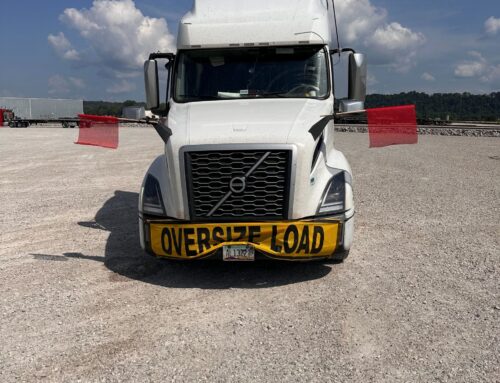
It’s essential they do. The Department of Transportation (DOT) mandates regular physical exams for commercial drivers to ensure they can safely perform their duties. By complying with these regulations, your employees not only protect their health and the safety of the public, but also maintain their employment status.
By embracing these stringent DOT physical requirements, a culture of accountability and safety is cultivated, which benefits everyone. Ensuring your drivers meet these standards fosters an environment where health is prioritized, ultimately contributing to a more reliable and secure operational framework. Encouraging compliance and awareness of these prerequisites exemplifies a commitment to excellence and public safety, which resonates profoundly within the industry.
1. What to Bring to a DOT Physical

Commercial drivers need to bring a complete list of their medications—dosages, regimen, and their doctors’ names and addresses. Additionally, filling out the health history questionnaire beforehand is recommended.
Accurate documentation can streamline the process, saving valuable time for both drivers and examiners.
To ensure the exam runs smoothly, drivers with vision or hearing problems must bring their eyeglasses or hearing aids. For those with diabetes, the latest Hemoglobin A1C results and blood sugar logs are required.
Drivers with heart-related issues should, at a minimum, bring a letter from their cardiologist detailing their medical history and current medications, confirming their safety to work.
1.1. List of Medications
To ensure a seamless DOT physical, a complete list of medications is crucial.
- Medication Names: Include all current prescribed and over-the-counter medications.
- Dosage Regimen: Specify how often the medications are taken.
- Dosages: Clearly mention the dosage amounts for each medication.
- Doctors’ Details: Provide the names and addresses of the prescribing doctors.
Accurate documentation helps avoid unnecessary delays during the examination.
Preparation and organization provide peace of mind, ensuring the DOT physical process is efficient and thorough.
1.2. Medical Documents for Specific Conditions
DOT physical requirements for CDL drivers necessitate various medical documents for those with specific conditions.
In 2016, the FMCSA implemented stricter regulations, ensuring drivers’ health and safety while on the road. These guidelines demand comprehensive documentation for anyone with pre-existing medical conditions.
For drivers with vision impairments, bringing their most recent optometrist report is crucial. It should attest to their visual acuity and suitability to meet DOT standards.
Similarly, drivers managing diabetes must submit up-to-date Hemoglobin A1C results and a detailed blood sugar log. Consistent monitoring helps medical examiners assess overall health.
In cases of heart conditions, a cardiologist’s letter is essential. This letter must outline the driver’s medical history and confirm their capability to safely perform their duties.
2. What the DOT Physical Covers
The DOT physical encompasses several vital health checks to ensure commercial drivers are fit for duty.
- Vision: Requires at least 20/40 acuity in each eye and a minimum of 70” peripheral in the horizontal meridian.
- Hearing: Drivers must perceive a “forced whisper” at a distance of 5 feet or less, equating to a hearing loss of less than 40 dB in the better ear.
- Blood pressure/pulse rate: The examiner checks blood pressure and pulse to detect high blood pressure and irregular heartbeats.
- Urinalysis: This test identifies underlying medical conditions like diabetes.
- Physical Examination: Covers general appearance, eyes, ears, mouth, throat, heart, lungs, chest, abdomen, vascular system, genito-urinary system, extremities, spine, musculoskeletal, and neurological health.
These assessments ensure that drivers can perform their duties without risking their safety or public safety.
Thorough and detailed, DOT physicals are pivotal in maintaining high standards for commercial driving.
2.1. Vision Requirements
Commercial drivers must meet specific vision standards to ensure their ability to operate vehicles safely.
- Visual Acuity: At least 20/40 vision in each eye with or without correction.
- Peripheral Vision: A minimum of 70 degrees in the horizontal meridian, in each eye.
- Eyeglass Prescription: Must bring current eyeglasses or contact lenses if corrective lenses are used.
These requirements guarantee that drivers have the necessary visual capacity.
Drivers with vision impairments must provide documentation from their optometrist or ophthalmologist.
2.2. Hearing Requirements
Hearing is critical for commercial drivers.
Drivers must meet specific hearing criteria to ensure safe vehicle operation. They need to discern a “forced whisper” at a distance of 5 feet or less, with or without the aid of hearing instruments. Essentially, this standard equates to an average hearing loss in the better ear of less than 40 dB.
Failure to meet these requirements can hinder certification.
Drivers with hearing difficulties must present adequate evidence – recent audiogram results from certified audiologists, for instance – to verify their ability to meet the necessary thresholds.
Ensuring robust auditory perception among commercial drivers significantly enhances road safety. Federal standards thus remain stringent and updated, reflecting the latest audiological evaluations, fostering a secure driving environment for all. Certified medical examiners play a crucial role in this rigorous hearing assessment.
2.3. Blood Pressure and Pulse Rate Check
Monitoring blood pressure and pulse rate is essential for assessing the cardiovascular health of commercial drivers.
- Blood Pressure: Regularly monitored to identify hypertension or other cardiovascular issues.
- Pulse Rate: Checked to detect irregular heartbeats or other anomalies.
High blood pressure may disqualify drivers if it poses a safety risk.
Medical examiners play a critical role in ensuring drivers meet the necessary cardiovascular standards for safe driving.
2.4. Urinalysis Test
A urinalysis test is an integral component of the DOT physical requirements for CDL drivers, as it helps identify underlying medical conditions.
Drivers must provide a urine sample which will undergo laboratory testing.
This test is primarily utilized to detect indications of diabetes, kidney disease, and other metabolic disorders. Additionally, it assesses for substances that may impair a driver’s ability to operate safely.
The results are critical in determining the overall health and fitness of a commercial driver. It is essential for drivers to maintain optimal health to continue their practice. By utilizing thorough evaluation protocols, such as urinalysis, the DOT ensures that safety-sensitive positions are entrusted to individuals who meet stringent health standards.
2.5. Physical Examination
The physical examination is a comprehensive assessment carried out by a certified medical examiner, encompassing a multitude of health categories.
Drivers undergoing this exam can expect a thorough evaluation of their overall physical health.
Specifically, examiners will check general appearance, which includes things like alertness and general demeanor.
Eye health, including conditions such as cataracts and glaucoma, will be meticulously evaluated.
In addition, the ears and hearing ability are scrutinized for issues like scarring or perforations of the eardrum, which could affect balance.
The examination also covers critical systems such as cardiovascular, respiratory, abdominal, musculoskeletal, and neurological functions. Each area is assessed to ensure the driver is healthy enough to safely operate a commercial vehicle.
3. Specific Physical Examination Areas

General appearance is closely evaluated during the examination.
Medical examiners assess the driver’s overall look for signs of significant health issues. This includes things like alertness, skin tone, and general demeanor. Their overall appearance can reflect underlying health conditions that may affect their ability to perform safety-sensitive duties effectively.
Eye health evaluations are paramount.
Examiners will meticulously check for cataracts, glaucoma, and other disorders. These conditions can affect the driver’s vision, which in turn affects their ability to operate a vehicle safely.
Heart health is another critical area – examiners listen for murmurs, irregular rhythms, and signs of heart disease. They may also consider previous heart-related surgeries and current cardiovascular medications.
These examinations underscore the importance of maintaining top physical condition to ensure safety on the roads. By identifying potential health issues early, the process helps CDL drivers manage risks and live healthier lives, ultimately contributing to safer public highways.
3.1. General Appearance
The general appearance evaluation is crucial for assessing a driver’s health and potential risks.
- Alertness: Examines if the driver is fully aware and responsive.
- Skin Tone: Checks for abnormal skin coloration indicating potential health issues.
- Demeanor: Observes the driver’s general behavior and emotional state.
This assessment helps identify visible signs of severe health conditions.
Ensuring drivers maintain good general health is vital for their safety and the public’s protection.
3.2. Eyes and Vision
The eyes provide critical visual information to drivers.
During the DOT physical, the examiner will test both near and distance vision. Drivers must achieve at least 20/40 vision acuity in each eye, with or without corrective lenses. Furthermore, the field of vision is evaluated to ensure peripheral awareness of at least 70 degrees in the horizontal meridian for each eye.
These standards ensure comprehensive visual capability.
Drivers bring their corrective lenses—glasses or contacts—if needed for their vision. The tests are designed to detect conditions like cataracts, glaucoma, and macular degeneration, which could impair driving safety.
Ensuring optimal eye health is paramount in maintaining road safety for everyone. Regular vision screenings as part of the DOT physical help identify issues early, allowing drivers to seek necessary treatments and interventions to preserve their ability to drive safely.
3.3. Ears and Hearing
Ensuring proper hearing ability is critical for safety-sensitive commercial drivers.
- Perception of forced whisper at 5 feet or less
- Average hearing loss in the better ear of less than 40 dB
- Use of hearing aids permitted during testing
Drivers must meet these auditory standards to ensure they can perceive essential sounds and signals on the road.
Drivers with hearing issues should bring their hearing aids to the examination.
Maintaining good hearing health is vital for detecting potential hazards, communication, and safe driving practices.
3.4. Mouth and Throat
The examination of the mouth and throat focuses on identifying issues that may hinder breathing, swallowing, or communicating effectively, which are essential functions for any commercial driver.
Signs of abnormalities may include redness, swelling, or abnormal lesions in the mouth or throat.
Furthermore, medical examiners check for obstructions and inflammation that might compromise airway function. Conditions like sleep apnea, which impairs breathing during sleep, may also be assessed.
Examiners may look for chronic tonsillitis, nodules, enlarged lymph nodes, or structural anomalies that could impact safe driving.
Catching these conditions early can lead to interventions that prevent serious complications, helping maintain the overall well-being of the driver. Clear communication and breathing are vital, and any issues identified can be addressed promptly.
Ultimately, this part of the exam highlights the necessity of ongoing health maintenance. Ensuring drivers are fit in these areas enhances safety and efficiency on the road.
3.5. Heart and Cardiovascular
Heart and cardiovascular health are pivotal components of the DOT physical requirements for CDL drivers.
Since 2016, due to increasing health awareness, regulations surrounding the cardiovascular health of drivers have become more rigorous, reflecting the growing emphasis on driver fitness and public safety.
Thus, it’s no longer sufficient to merely check a driver’s heartbeat; a thorough examination is necessary to detect underlying conditions such as murmurs, extra sounds, pacemakers, or other abnormalities.
To assess the condition of the heart, medical examiners may order an electrocardiogram or other diagnostics to understand the heart’s rhythms and electrical activity, especially if the driver has a history of heart disease.
In summary, ensuring a driver’s cardiovascular system is robust enough to handle the strenuous demands of driving is essential for safety on the road.
3.6. Lungs and Chest
Lung and chest health is critical, ensuring that commercial drivers can maintain alertness and manage physical strain effectively.
The evaluation, in this capacity, involves a comprehensive physical examination of the respiratory system, including the lungs and chest, which aims to uncover any abnormalities or impediments to proper breathing. Conditions such as abnormal breathing patterns, impaired respiratory functions, and cyanosis are carefully scrutinized to safeguard both the driver and public safety.
Additionally, drivers are required to undergo routine chest examinations to detect potential issues. The accountability of this process ensures drivers have the capacity to perform their duties without suffering from compromised lung health or breathing difficulties.
Moreover, a thorough inspection includes listening to breathing sounds through a stethoscope, checking for any abnormalities like wheezing, crackles, or other atypical respiratory sounds. Such meticulous screenings help identify underlying medical issues, preventing them from escalating and ensuring a driver’s sustained well-being on the road.
3.7. Abdomen and Viscera
The assessment of the abdomen and viscera focuses on detecting any abnormalities, organ enlargements, or muscle weaknesses in this crucial area, significantly impacting a driver’s ability to perform their duties safely.
Medical examiners palpate the abdomen.
They check for tenderness, masses, or abnormal enlargements that could indicate underlying health issues.
Drivers with gastrointestinal problems may need to bring additional documentation from their healthcare provider.
Inflammations, infections, or other visceral conditions can potentially impair a driver’s ability to operate a commercial vehicle.
It is essential to ensure that a driver’s abdominal and visceral health is in optimal condition. Comprehensive examination practices serve as preventive measures, ensuring drivers remain healthy and roadworthy.
3.8. Vascular System
The vascular system examination assesses the cardiovascular health of commercial drivers, crucial for safe vehicle operation.
- Medical history review for cardiovascular conditions
- Pulse check for abnormalities
- Examination for signs of varicose veins
- Assessment for carotid artery issues
Thorough examination ensures early detection of vascular impairments.
Drivers should provide relevant medical records to streamline the assessment process.
3.9. Genito-urinary System
The genito-urinary system includes the bladder, kidneys, reproductive organs, and associated structures.
During the DOT physical, the medical examiner will perform a cursory examination to identify any abnormalities, such as hernias, that could interfere with safe driving. Drivers with known genito-urinary issues are advised to bring pertinent medical records and documentation from their healthcare providers.
Typically, drivers who have had surgery in this area must provide clearance from their surgeon. As part of the urinalysis, the examination also helps detect underlying conditions that might affect the renal and urinary tract.
Overall, the genito-urinary evaluation is crucial in identifying issues that could impact a driver’s ability to maintain focus and physical comfort. Comprehensive assessments ensure that commercial drivers are not compromised by conditions related to the genito-urinary system, thus promoting their well-being and public safety.
3.10. Extremities
The examination of extremities is an essential aspect of the DOT physical process.
Since 2016, medical examiners, as part of the comprehensive assessment protocol, perform a thorough evaluation of a driver’s extremities. They pay particular attention to the range of motion, joint function, and any signs of impairment.
This is to ensure that a driver’s physical capabilities are not compromised by conditions such as missing limbs, muscle weakness, or severe arthritis, which could hinder their ability to operate a commercial vehicle safely.
Moreover, the assessment of the extremities also includes checking for any signs of nerve damage, swelling, or other impairments that might affect the driver’s physical performance. Such conditions could impact tasks that require precision and strength, essential for maneuvering and controlling heavy vehicles.
By evaluating these factors, medical examiners help ascertain that drivers possess the necessary physical abilities to perform their duties effectively and responsibly.
3.11. Spine and Musculoskeletal
The spine and musculoskeletal examination focuses on identifying potential issues affecting the driver’s abilities.
In this section, the medical examiner checks for any limitations in motion, discomfort, or deformities in the spine or other skeletal structures. They assess the driver’s ability to perform essential tasks without pain or restriction. Conditions such as scoliosis, kyphosis, or past surgical interventions are carefully reviewed to understand any potential impact on the driver’s functionality.
Examiners also scrutinize the candidate’s musculature for signs of imbalance or atrophy. This part of the test ensures that the driver has the required physical strength and endurance necessary for safe vehicle operation, particularly in situations demanding quick reactions.
Proper evaluation of the spine and the musculoskeletal system is vital in ensuring that commercial drivers can handle the physical demands of their job. By identifying potential health risks, the DOT physical helps maintain safety standards, ensuring that drivers are well-prepared to face the challenges of their profession.
3.12. Neurological System
Examiners assess the functionality of the driver’s neurological system for any impairments. They evaluate coordination, reflexes, balance, and overall nervous system health.
This ensures drivers can respond quickly to situational demands.
Any neurological impairments could compromise a driver’s ability to control the vehicle safely. Conditions like impaired equilibrium, ataxia, or asymmetric deep tendon reflexes warrant thorough evaluation to determine the extent of their impact on driving performance.
Through precise examination of the neurological system, medical examiners can identify potential risks that may affect a driver’s operational capacity. By ensuring drivers are neurologically sound, the DOT physical supports both individual well-being and public safety within the transportation industry.
4. DOT Physical Forms

DOT physical forms are essential documents that record, verify, and ensure a commercial driver’s compliance with health requirements mandated by the FMCSA.
These forms provide a structured method for medical examiners.
Initially, the Medical Examination Report (MER) Form, MCSA-5875, collects the driver’s health history.
The medical examiner completes the form during the physical examination to document their findings.
For drivers with diabetes, the Insulin-treated Diabetes Mellitus Assessment, MCSA-5870, needs to be completed and is crucial for the issuance of the Medical Examiner’s Certificate.
This meticulous documentation process ensures that all health aspects are evaluated thoroughly. Properly completed forms safeguard both the driver’s well-being and public safety.
4.1. Medical Examination Report (MER) Form, MCSA-5875
The Medical Examination Report (MER) Form, MCSA-5875, stands as a critical cornerstone of the DOT physical examination, serving to comprehensively capture the driver’s health information.
Drivers are required to accurately fill out their medical history.
This document encompasses a thorough review of systems and medical history, including current medications, previous surgeries, chronic conditions, and any pertinent health concerns that may impact driving capability.
Accurate completion of the MER form ensures that medical examiners can make informed decisions about a driver’s fitness to operate commercial vehicles. It is imperative for drivers to be forthright and detailed in their responses, as this information forms the basis of their medical certification. This detailed form acts as the “map” guiding the examiner through the driver’s health landscape.
4.2. Medical Examiner’s Certificate (MEC), Form MCSA-5876
Once a driver successfully passes their DOT physical examination, they are awarded the Medical Examiner’s Certificate (MEC), Form MCSA-5876.
This certificate, an essential document for all commercial drivers, serves as verification that they meet the rigorous health standards mandated by the Federal Motor Carrier Safety Administration (FMCSA). Holding this certificate confirms their ability to operate a commercial vehicle safely. The MEC must be kept on hand, reflecting the driver’s ongoing compliance with DOT physical requirements.
Importantly, the MEC is valid for up to 24 months, unless the medical examiner issues a certificate for a shorter duration due to specific health conditions. This ongoing certification process ensures that drivers remain in optimal health while on the road, safeguarding public welfare and their own well-being.
Employers must ensure their drivers hold a current MEC to prevent any disruptions in operations. Working with FMCSA-certified physicians who understand the stringent requirements can facilitate this process, thus maintaining seamless compliance and operational efficiency.
4.3. Insulin-treated Diabetes Mellitus Assessment, MCSA-5870
For drivers with insulin-treated diabetes, meticulous attention to the MCSA-5870 form is paramount. This document needs completion by their treating clinician within a stringent 45-day window preceding the physical examination.
Accuracy in this form is vital, as it directly impacts the driver’s certification status. Drivers must exhibit well-managed diabetes to ensure road safety.
Clinicians must provide comprehensive details on the driver’s diabetes management plan, including recent HbA1c levels and any insulin regimen adjustments. Additionally, they should attest to the driver’s ability to perform safety-sensitive duties without hypoglycemic risk.
Submitting an MCSA-5870 form in perfect order ensures there are no delays in certifying the driver. This step guarantees that drivers can uphold their roles while managing their condition effectively, contributing to overall road safety and operational continuity.
5. Benefits of Using Certified Medical Examiners

Trusting certified medical examiners ensures that DOT physicals are conducted accurately, adhering to FMCSA regulations. Certified medical examiners possess the expertise necessary to identify potential health risks, ensuring that commercial drivers remain fit for duty.
Employers benefit from reduced liability when using certified medical examiners. They follow standardized procedures that comply with legal requirements.
Certified medical examiners provide comprehensive assessments. Their training and certification guarantee a thorough examination process.
This certified expertise offers drivers confidence in their health status, acknowledging professional oversight. The examination thus supports a safer driving environment.
Improved driver safety leads to fewer accidents and injuries, benefiting all road users. Employers also find that healthier drivers can lead to higher productivity rates.
Ultimately, using certified medical examiners is an investment in public safety. Their involvement helps maintain high health standards among commercial drivers, promoting compliance with DOT requirements.
6. Contact a DOT Expert for More Information
Consulting with a DOT expert can provide invaluable insights and personalized guidance for your company’s specific needs.
These experts, with extensive knowledge in regulatory compliance and health standards, can streamline the entire process, ensuring that all DOT physical requirements for CDL drivers are thoroughly met. Their input can save time, mitigate risks, and ensure seamless adherence to legal mandates.
Additionally, their expertise can act as a significant resource for addressing any complex questions or unique scenarios that may arise. Their familiarity with the latest updates ensures your team remains informed and compliant with any new regulations or changes.
Concentra’s DOT experts specialize in these precise requirements, providing comprehensive support tailored to your organization’s needs. By leveraging their knowledge, employers can foster a safer, more productive work environment while guaranteeing their drivers remain compliant and healthy for the road ahead.

DOT Physical Exam Locations in Phoenix, Arizona
If you’re a commercial driver in Phoenix, Arizona, and need to complete your DOT physical exam, here are some locations where you can get it done:
- Concentra Urgent Care
- Address: 1818 E Sky Harbor Cir N, Phoenix, AZ 85034
- Phone: (602) 244-9500
- Website: Concentra
- NextCare Urgent Care
- Address: 1701 E Thomas Rd, Phoenix, AZ 85016
- Phone: (602) 845-9100
- Website: NextCare
- FastMed Urgent Care
- Address: 3131 E Thunderbird Rd, Phoenix, AZ 85032
- Phone: (602) 992-8300
- Website: FastMed
- Banner Urgent Care
- Address: 9305 W Thomas Rd, Phoenix, AZ 85037
- Phone: (623) 465-6330
- Website: Banner Health
- HealthPoint Urgent Care
- Address: 3931 E Camelback Rd, Phoenix, AZ 85018
- Phone: (602) 368-5830
- Website: HealthPoint
- MinuteClinic at CVS
- Address: 1610 E Camelback Rd, Phoenix, AZ 85016
- Phone: (602) 265-4755
- Website: MinuteClinic
- CareSpot Urgent Care
- Address: 3131 E Greenway Rd, Phoenix, AZ 85032
- Phone: (602) 992-8300
- Website: CareSpot
- HonorHealth Medical Group
- Address: 9250 N 3rd St, Phoenix, AZ 85020
- Phone: (602) 943-2381
- Website: HonorHealth
- MedPost Urgent Care
- Address: 1701 E Thomas Rd, Phoenix, AZ 85016
- Phone: (602) 845-9100
- Website: MedPost
- Phoenix Medical Group
- Address: 4350 E Camelback Rd, Phoenix, AZ 85018
- Phone: (602) 955-8700
- Website: Phoenix Medical Group
These locations offer DOT physical exams to ensure you meet the necessary requirements for your CDL. Be sure to call ahead to confirm availability and any specific documentation you may need to bring.













